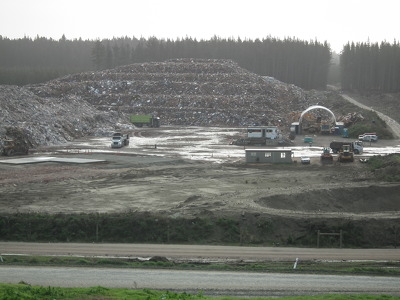
Damaged road around the Avon-Heathcote Estuary.

Earthquake rubbish dump at Bottlelake Forest.

A map of Christchurch soils.

Erosion scarp along North New Brighton Beach.

A truck dumps rubbish.

A map of Canterbury Earthquake Recovery Authority residential zones in Christchurch.

A scanned copy of a photograph of an optical diffraction pattern produced by the He-Ne Continuous Gas Laser used in David Lockwood's MSc research at the University of Canterbury. David explains that the photograph shows "a typical optical diffraction pattern obtained from the original red laser beam arising from a grating structure formed by the alignment of a colloid under the influence of a travelling sound wave".

A scanned copy of a black and white photograph of the argon gas laser used by David Lockwood in his PhD research at the University of Canterbury. David says, "In contrast to the He-Ne laser I developed for my MSc thesis, the laser I used was one of the first commercial lasers - an argon gas laser that required frequent painstaking maintenance. This was because the He-Ne gas laser did not produce enough power for my experiments".

A scanned copy of a black and white photograph of the He-Ne Continuous Gas Laser used in David Lockwood's MSc research at the University of Canterbury. David says, "The experiments in the Thesis were aimed at examining the effects of sound waves on colloids, which are very small particles that are found in clays for example (for more details see page 181 of http://www.cap.ca/PiC-PaC/static/downloads/1efdc1f3784b85c1a1b33e396b91ee8aef2072c5.pdf ). In fact, I was looking at nanoparticles of matter, which preceded the emergence of nanotechnology as a field of research by more than two decades. I needed a suitable light source to probe the alignment of the nanoparticles in the ultrasonic sound field. At that time the laser had just been invented and I realized that this was the ideal light source for my experiment. I then proceeded to construct the first home-built laser in New Zealand. This laser - a He-Ne continuous-wave gas laser - operated at 632.8 nm (in the red). This laser, over a metre long, is shown in the black-and-white photo. There were lot of problems to be overcome, but eventually, with invaluable help from Dr. Tom Seed (my MSc supervisor) and Dr. Rod Syme, I had it working".

A scanned copy of a black and white photograph of David Lockwood standing beside the computer-controlled laser Raman spectroscopy equipment he used for his PhD research at the University of Canterbury. David says, "This thesis is concerned with setting up the first computer-controlled laser Raman spectroscopy equipment (shown in one photo - that's me wearing the laser safety goggles) in New Zealand and using it to measure the vibrational spectrum of novel materials grown in the Physics Department. It is very likely that my setup was also the first in the Southern Hemisphere".